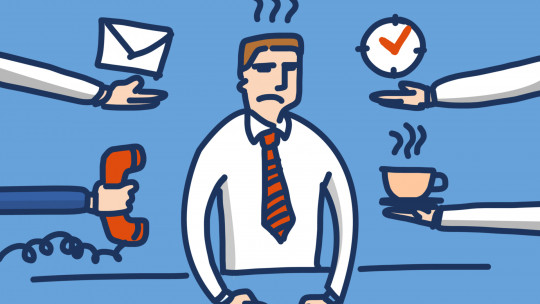In our globalized world, high unemployment rates, economic instability, the postponement of the moment of emancipation of young people from their homes and the increase in demands to access a decent job, have caused people to feel increasingly threatened. for the work area. In this, values such as individuality and competitiveness prevail, which favors an image of work linked to a dangerous place and potentially linked to loss, threatening feelings that generate helplessness. A conception of work is then configured that is radically opposed to “a means by which to carry out personal projects and support oneself economically.”
The place that work occupies within the framework of our personal fulfillment is the subject of study by various contemporary thinkers and philosophers, a discussion that will be left out of this article. However, and this is where we want to point out, the real problem with this view is that these structural changes in the world of work have led to people developing unhealthy levels of stress and anxiety. So is the fact that mental health problems at work have become common. In that sense, it is important to question the values that permeate society and that can be harmful to people’s well-being.
As Zygmunt Bauman has pointed out, “Questioning the ostensibly unquestionable premises of our way of life is undoubtedly the most pressing service we owe ourselves,” which is to say that there is a unique thought linked to our way of life, which must be reflected upon individually. . However, in line with this purpose, It is necessary to distinguish the differences between stress and anxiety at work a topic that we will address in this article, since ignorance of the distinction between both concepts could lead people to postpone the moment of making a consultation with a mental health professional.
What is work stress?
Stress, contrary to the common sense notion that is often promulgated, is not negative or something that we should eradicate from our lives. This is what is called positive stress. In fact, if we did, it would be something like having a car and taking off the wheels: without the stress, we wouldn’t be able to go anywhere.
Stress is an adaptive mechanism that refers to a set of physiological changes that allow an organism to adapt to a stressful stimulus We say that it is adaptive because it allows us to give a response that is functional to the adaptation to the environment. If we perceive a threat—for example, noticing that the bridge we are walking on is a little loose—stress triggers a nervous response that promotes the production of adrenaline to take quick and effective action—running away from the bridge—as a way to escape. response to stressful stimulus.
So, the success of our adaptation to the challenges that we face every day depends on whether we can get stressed. If we focus on the workplace, it is thanks to stress that we can respond to a client’s demand or meet a deadline or deadline. However, long working hours and very demanding jobs that the individual sees as being unable to perform can imply overexposure to this stress—which, we repeat, is not negative in itself—but whose persistence can become problematic. We could call it negative stress.
This is because the body executes a series of responses aimed at resolving the stressful problem, behaviors that have traditionally been categorized as fight, flight or freeze, but which may not be enough to end the stressor. At this point, as the nervous response was not enough, the body triggers an endocrine response from the activation of the hypothalamic-pituitary-adrenal axis the result of which is a production of cortisol, the hormone responsible for evoking stress responses throughout the body.
The problem is that an overproduction of cortisol could have severe consequences on a physical, cognitive and behavioral level. If we are permanently exposed to high-demand situations at work to which we cannot give efficient responses, the stress will end up becoming chronic, potentially triggering a pathology.
Burnout: the pathology of work stress
One of the most studied pathologies in recent years in relation to stress is work stress, also called burnout or burnout syndrome. It is a mental disorder of stress at work that manifests itself as physical fatigue, burnout, progressive loss of energy, exhaustion and lack of personal fulfillment in relation to work projects. He burnout predominates among public health personnel —doctors, nurses— and other professions that involve caring for people in a state of vulnerability, since these professionals are usually exposed to on-call duties, long and unsustainable working hours, and little remuneration.
However, the possibility of suffering from this pathology is not limited to exclusively these professionals. He burnout It is characterized by the feeling that one’s work is unrewarding and the lack of recognition towards it; also due to the person’s difficulty in discriminating the personal world from the professional. For those who suffer from this syndrome, both dimensions of life are equivalent, and professional concerns destroy any glimpse of personal pleasures that go beyond work.
Anxiety at work
However, constant exposure to stressful situations at work could trigger emotional responses more closely linked to anxiety. Anxiety, like stress, is a normal and adaptive response, since it allows us to anticipate the future to carry out more appropriate behaviors in the present. Feeling anxiety gives us the possibility of devising a plan, since we are anticipating an imminent danger, and also allows us to consider the consequences of our actions. Some authors consider anxiety as part of the evolutionary fight-or-flight survival reaction, triggered by stress.
Nevertheless, At work, some people may experience anxiety in situations that are not truly threatening Also, people who experience anxiety at work often perceive a vague and diffuse threat during work hours, or when they are immersed in it, but are unable to detect what they are afraid of. On the contrary, they usually perceive their discomfort through other somatic symptoms and body pains with non-organic causes instead of being aware of their anxiety. This is very common in patients who suffer from generalized anxiety disorder (GAD). Therefore, anxiety at work could be expressed in headaches and neck pain, sweaty hands or feelings of suffocation; but also in specific behaviors such as avoiding work events, postponing or procrastinating difficult tasks, or difficulties maintaining attention.
To detect any of these symptoms in relation to work, whether they are linked to stress or anxiety, it is necessary to go to a mental health professional and receive appropriate advice and therapy. Self-diagnosis or prolonged self-medication is not appropriate. To dispel any type of doubt and receive appropriate treatment, it is important not to self-diagnose any pathology and go to a mental health professional.









